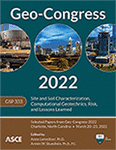Appraisal of Scale Effects in Centrifuge Modeling for the Prediction of Ultimate Settlement of Slurries
Publication: Geo-Congress 2022
ABSTRACT
The self-weight consolidation testing of slurry material in a centrifuge environment reduces the testing time significantly and simulates better field stress conditions. However, variation in the centrifuge acceleration with the depth of the model poses a challenge in interpreting the results. The settlement behavior of a prototype of fixed height was predicted from numerically simulated centrifuge consolidation test data using the scale factors corresponding to various effective-radii and model base values. The predicted settlement behavior was compared with the simulated prototype settlement. The ultimate settlement was under-predicted using the constant-N as the scale factor. The maximum error in ultimate settlement with base N was 3.74%, which was much less compared to the other cases where the model height to centrifuge radius ratio was kept below 0.25.
Get full access to this article
View all available purchase options and get full access to this chapter.
REFERENCES
Been, K., and Sills, G. C. (1981). Self-weight consolidation of soft soils: an experimental and theoretical study. Geotechnique, 31(4), 519–535.
Bharat, T. V., and Ubaid, M. (2019). Analytical model for consolidation settlements under centrifuge environment. Canadian Geotechnical Journal, 56(4), 484–494.
Bloomquist, D. (1982). Centrifuge Modeling of Large-strain Consolidation Phenomena in Phosphatic Clay Retention Ponds (Florida). Diss. University of Florida.
Cargill, K. (1982). Consolidation of soft layers by finite strain analysis. MP-GL82-3. Geotechnical Laboratory, U. S. Army Engineer Waterways Experiment Station, Vicksburg, Miss.
Cooke, B. (1991). Selection of operative centrifuge radius to minimize stress error in calculations. Canadian Geotechnical Journal, 28(1): 160–161. doi:https://doi.org/10.1139/t91-017.
Croce, P., Pane, V., Znidarcic, D., Ko, H.-Y., Olsen, H. W., and Schiffman, R. L. (1985). Evaluation of consolidation theories by centrifuge modelling. In Proceedings of the International Conference on Applications of Centrifuge Modelling to Geotechnical Design, Balkema, Rotterdam, the Netherlands, pp. 380–401.
Fox, P. J., Lee, J., and Qiu, T. (2005). Model for large-strain consolidation by centrifuge. International Journal of Geomechanics, 5(4): 267–275. doi:10.1061/ (ASCE)1532-3641(2005)5:4(267).
Gibson, R. E., England, G. L., and Hussey, M. J. L. (1967). The theory of one-dimensional consolidation of saturated clays. I. Finite non-linear consolidation of thin homogeneous layers. Geotechnique, 17(3): 261–273. doi:10.1680/.
Lee, K. (1979). An analytical and experimental study of large-strain soil consolidation. Ph.D. thesis, Trinity, UK.
McVay, M., Townsend, F., and Bloomquist, D. “Quiescent consolidation of phosphatic waste clays.” Journal of Geotechnical Engineering 112.11 (1986): 1033–1049.
Ortenblad, A. (1930). Mathematical theory of the process of consolidation of mud deposits. Journal of Mathematics and Physics, 9(1–4): 73–149. doi:10.1002/sapm19309173.
Robinson, R. G., Tan, T. S., and Lee, F. H. (2003). A comparative study of suction induced seepage consolidation versus centrifuge consolidation. Geotechnical Testing Journal, 26(1): 92–101. doi:https://doi.org/10.1520/GTJ11109J.
Schofield, A. N. (1980). Cambridge geotechnical centrifuge operations. Geotechnique, 30(3): 227–268. doi:https://doi.org/10.1680/geot.1980.30.3.227.
Sorta, A. R., Sego, D. C., and Wilson, W. (2016). Physical modelling of oil sands tailings consolidation. International Journal of Physical Modelling in Geotechnics, 16(2): 47–64. doi:https://doi.org/10.1680/jphmg.15.00006.
Suthaker, N. N. (1995). Geotechnics of oil sand fine tailings. Ph.D. thesis, University of Alberta, Canada.
Taylor, R. N., ed. (1995). Centrifuges in modelling: principles and scale effects. In Geotechnical centrifuge technology. Blackie Academic & Professional, London, UK., pp. 19–33.
Information & Authors
Information
Published In
History
Published online: Mar 17, 2022
Authors
Metrics & Citations
Metrics
Citations
Download citation
If you have the appropriate software installed, you can download article citation data to the citation manager of your choice. Simply select your manager software from the list below and click Download.
